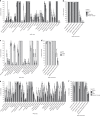Abundance and diversity of resistomes differ between healthy human oral cavities and gut
- PMID: 32019923
- PMCID: PMC7000725
- DOI: 10.1038/s41467-020-14422-w
Abundance and diversity of resistomes differ between healthy human oral cavities and gut
Abstract
The global threat of antimicrobial resistance has driven the use of high-throughput sequencing techniques to monitor the profile of resistance genes, known as the resistome, in microbial populations. The human oral cavity contains a poorly explored reservoir of these genes. Here we analyse and compare the resistome profiles of 788 oral cavities worldwide with paired stool metagenomes. We find country and body site-specific differences in the prevalence of antimicrobial resistance genes, classes and mechanisms in oral and stool samples. Within individuals, the highest abundances of antimicrobial resistance genes are found in the oral cavity, but the oral cavity contains a lower diversity of resistance genes compared to the gut. Additionally, co-occurrence analysis shows contrasting ARG-species associations between saliva and stool samples. Maintenance and persistence of antimicrobial resistance is likely to vary across different body sites. Thus, we highlight the importance of characterising the resistome across body sites to uncover the antimicrobial resistance potential in the human body.
Conflict of interest statement
The authors declare no competing interests.
Figures





Similar articles
-
Probiotics impact the antibiotic resistance gene reservoir along the human GI tract in a person-specific and antibiotic-dependent manner.Nat Microbiol. 2021 Aug;6(8):1043-1054. doi: 10.1038/s41564-021-00920-0. Epub 2021 Jul 5. Nat Microbiol. 2021. PMID: 34226711 Free PMC article.
-
Comparative diversity of microbiomes and Resistomes in beef feedlots, downstream environments and urban sewage influent.BMC Microbiol. 2019 Aug 27;19(1):197. doi: 10.1186/s12866-019-1548-x. BMC Microbiol. 2019. PMID: 31455230 Free PMC article.
-
Antibiotic resistomes of healthy pig faecal metagenomes.Microb Genom. 2019 May;5(5):e000272. doi: 10.1099/mgen.0.000272. Epub 2019 May 15. Microb Genom. 2019. PMID: 31091181 Free PMC article.
-
Overview of bioinformatic methods for analysis of antibiotic resistome from genome and metagenome data.J Microbiol. 2021 Mar;59(3):270-280. doi: 10.1007/s12275-021-0652-4. Epub 2021 Feb 23. J Microbiol. 2021. PMID: 33624264 Review.
-
Effects of Antimicrobial Agents Used for Dental Treatments: Impacts on the Human Oral Ecosystem and the Resistome.Adv Exp Med Biol. 2025;1472:261-275. doi: 10.1007/978-3-031-79146-8_16. Adv Exp Med Biol. 2025. PMID: 40111697 Review.
Cited by
-
Comparative Genomics Revealed a Potential Threat of Aeromonas rivipollensis G87 Strain and Its Antibiotic Resistance.Antibiotics (Basel). 2023 Jan 9;12(1):131. doi: 10.3390/antibiotics12010131. Antibiotics (Basel). 2023. PMID: 36671332 Free PMC article.
-
Performance Characteristics of Next-Generation Sequencing for the Detection of Antimicrobial Resistance Determinants in Escherichia coli Genomes and Metagenomes.mSystems. 2022 Jun 28;7(3):e0002222. doi: 10.1128/msystems.00022-22. Epub 2022 Jun 1. mSystems. 2022. PMID: 35642524 Free PMC article.
-
Metagenomic Insight into The Global Dissemination of The Antibiotic Resistome.Adv Sci (Weinh). 2023 Nov;10(33):e2303925. doi: 10.1002/advs.202303925. Epub 2023 Oct 23. Adv Sci (Weinh). 2023. PMID: 37870180 Free PMC article.
-
Putative mobilized colistin resistance genes in the human gut microbiome.BMC Microbiol. 2021 Jul 22;21(1):220. doi: 10.1186/s12866-021-02281-4. BMC Microbiol. 2021. PMID: 34294041 Free PMC article.
-
Mobile Genetic Elements Drive Antimicrobial Resistance Gene Spread in Pasteurellaceae Species.Front Microbiol. 2022 Jan 6;12:773284. doi: 10.3389/fmicb.2021.773284. eCollection 2021. Front Microbiol. 2022. PMID: 35069478 Free PMC article.
References
-
- World Health Organisation. Antimicrobial Resistance: Global Report on Surveillance. (WHO Press, World Health Organisation, Geneva, 2014). https://eur03.safelinks.protection.outlook.com.
Publication types
MeSH terms
Substances
Grants and funding
LinkOut - more resources
Full Text Sources
Medical

